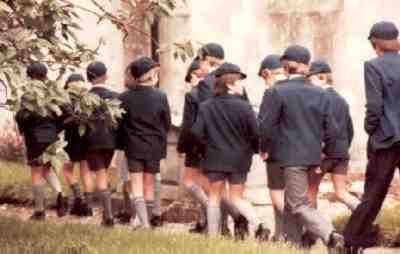
Figure 1.--Prep schoolboys put on their best uniforms for church on snday. Notice the prefects wearvlong trousers. Also notice that caps were still worn at this traditional school.

 Figure 1.--Prep schoolboys put on their best uniforms for church on snday. Notice the prefects wearvlong trousers. Also notice that caps were still worn at this traditional school. |
English schools have had a variety of policies and regulations about the school uniform and wearing shorts. Beginning in the 1960s older English boys stopped wearing short pants as commonly as they once did, even for casual dress. Slowly British schools began to lower the age at which boys had to wear shorts and gradually most schools dropped the requirement all together.
Schools regulations on shorts varied over time. Shorts were widespread in many most primary schools and private preparory schools. Many grammar schools (academically selective secondary schools) and secondary modern schools required them in the first year or two. Even in the secondary schools that did not requite the junior boys to wear them, many boys did not, but this generally declined in the 1970s. Many public schools (private secondary schools) requird junior boys to wear shorts. A few required the senior boys to wear them as well, but many of these requirements were generally dropped in the 1970s.
The 1920s: Short pants became commonly worn at preparatory schools. At the same time blazers and shirts with soft collars replaced Eton suits at private schools. I'm not sure to what extent state schools required shorts. I think it may have been more a reflection of what boys were wearing at home. The private schools, however, tended to have very detailed uniform requirements.
The 1930s: Shorts were almost universally worn at English elementary schools and preparatory schools. I do not think that regulations at the state schools required them, but the private preparatory schools probably did.
The 1940s: I do not know of any major change during the 1940s. Some unconfirmed reports suggest that war time shortages incouraged the production of shorts rather than long trousers for boys, but I am not sure about this.

Figure 4.--The shorter Continental style of short pants became common at British schools in the 1970s. |
Schools had different regulations involving short pants. Common practices differed widely from school to school. Many elementry and prep schools were all shorts until the 1970s when older boys were allowed to wear longs and various regulations were instituted to govern this.
Age: Some schools set an age limits for wearing short pants. A common regulation at prep sschools in the 1980s, for example, was to allow boys to wear longs when they reached 11 or 12 years of age, depending on the school.
Form: Another common requirement was to base the wearing of shorts on the form (grade) the boy was in. Usually boys in the 5th or 6th form of prep schools were allowed to wear longs. This was the general practice at the private and state secondary schools which continued to require short pants. Usually it was the first or second forms that had to wear them.
Height: Less common, but used at some schools, wearing shorts was determined by height. This was less popular than other practices because it meant that if a boy was short, he might have to wear shorts, even as a senior boy. It was mostly used at a few public (private secondary schools). Sedbury in Yorkshire, for example, in the 1960s set a height of 5 feet 6 inches to qualify for wearing long trousers.
Optional: Some schools made shorts optional. In such instances at most schools the boys, except for the vary youngest would usually wear long pants.
Navigate the Historic Boys' Clothing Web Site:
[Return to the Main school uniform garment page]
[Introduction]
[Chronologies]
[Style Index]
[Biographies]
[Bibliographies]
[Contributions]
[Frequently Asked Questions]
[Links]
[Boys' Clothing Home]
